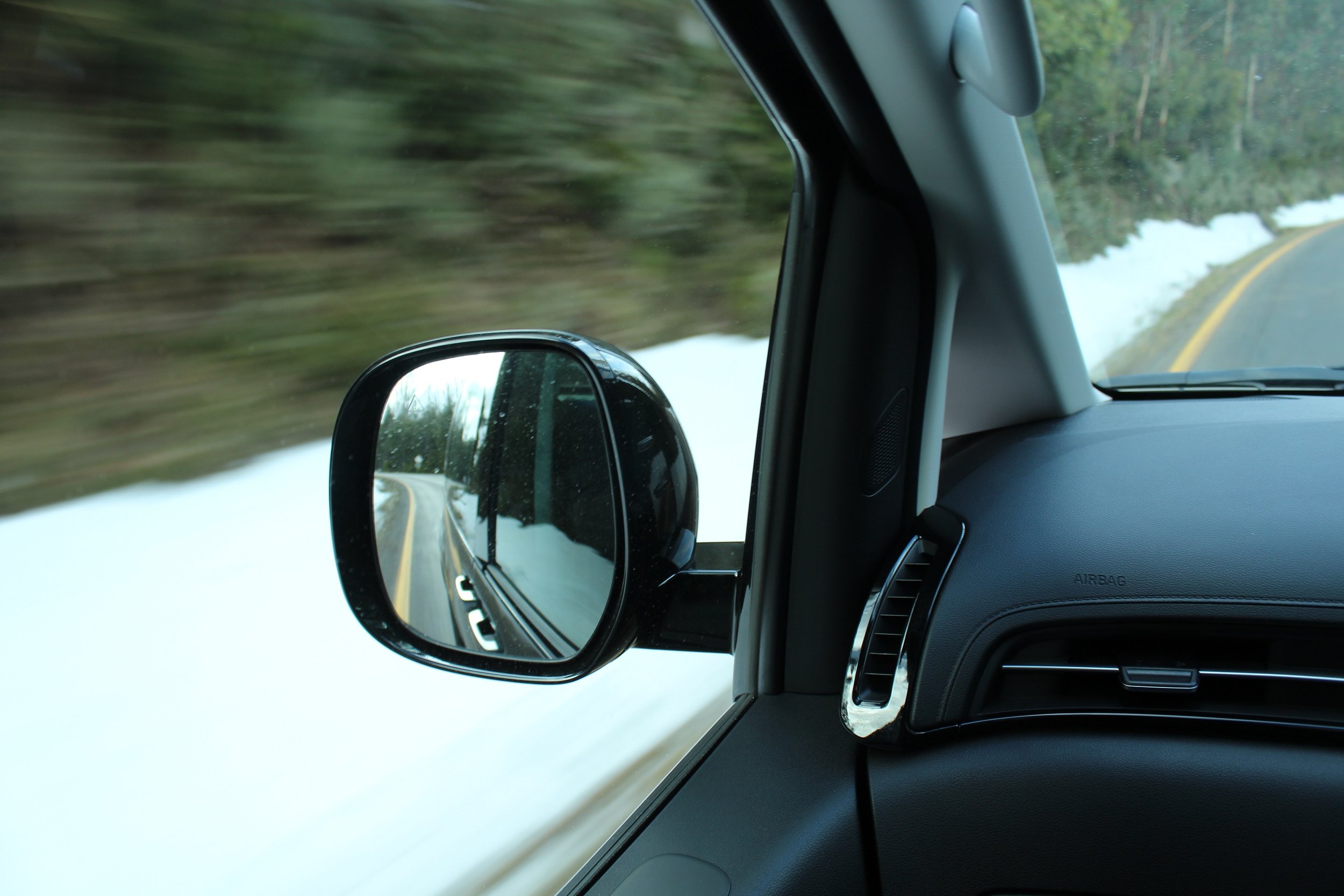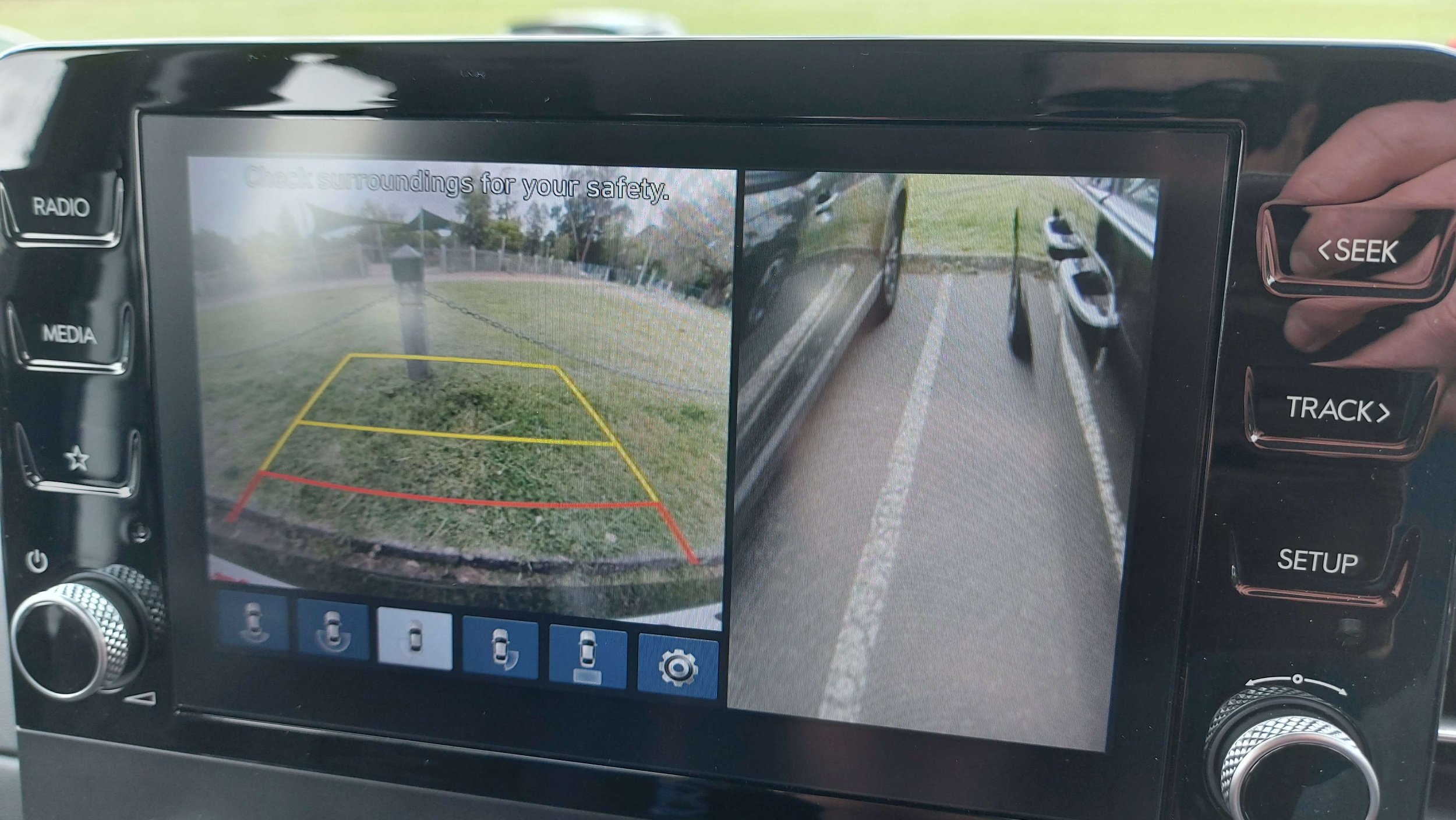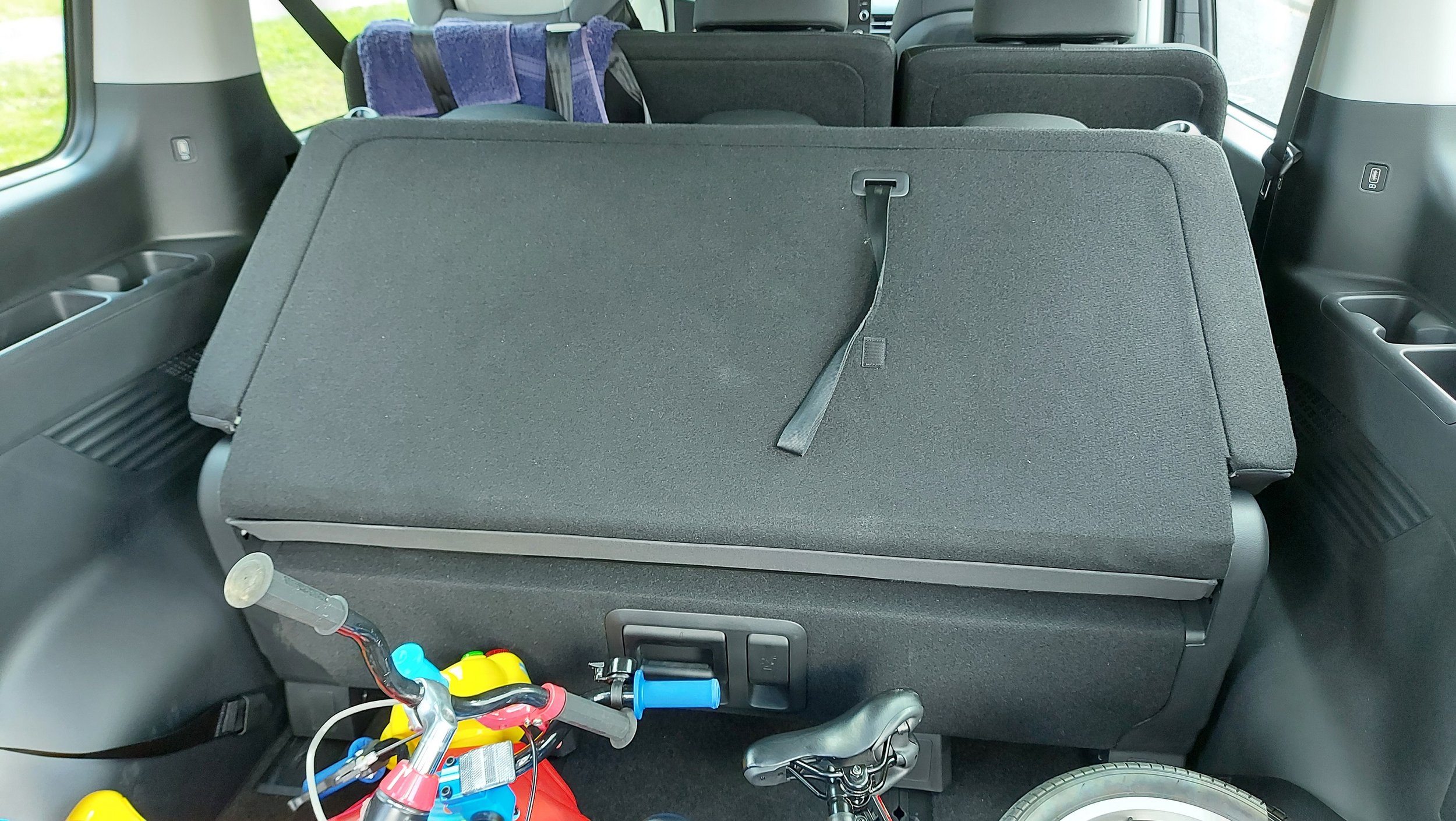Hyundai Staria review and buying guide
There are large SUVs that try hard to offer space, comfort and practicality, but the Hyundai Staria is a master at making your kids - and their gear - disappear…
The Hyundai Staria is the biggest family car you've ever seen - and that’s saying something when every new model just a little longer, little bit taller, and a fraction wider. “More, more, more…” said Agent Smith in The Matrix Reloaded.
Forget seven-seat SUVs when it comes to big families, enormous baskets of washing and a truckload of teenagers lacking even a granule of gratitude as you ferry them to footy, netball and hockey practice. This is where the Hyundai Staria is going to be your teammate. It’s time for a family meeting...
Now. Before you scoff and think people movers aren’t sexy, cool or - dare I suggest - fashionable, I’ll have you know I’m currently wearing a cardigan I bought back in 2013. People movers are brilliant, utilitarian multi-purpose tools designed for moving the maximum volume of human being - or Great Danes - as far as may be required. And their stuff.
I was loaned two Staria grades courtesy of Hyundai Australia: the first was the 3.5L V6 petrol front-wheel-drive base model in November 2021, and the Highlander diesel with all-wheel drive in July 2022 - for a week each, full of fuel.
You’ll want to also look at the Hyundai Palisade 8-seater to see if it’s big enough already without going full-Staria.
If your kids are no longer in child restraints, but are still several years away from leaving the nest, there’s good chance you’re shopping for a large SUV or Kia Carnival, (but hopefully not a Honda Odyssey or Volkswagen Multivan). I’m here to advise you the Staria might be far more appropriate. (Although, the Carnival is great in most circumstances, especially when they’re still in seating restraints.)
As teenagers, your kids, I’m guessing, are two meals and a mullet away from rivalling a small football club, in both size and attitude. And they still raid your fridge before heading to a mate’s house. You’re probably in the market for a people mover, potentially. Because quite often, a seven-seat SUV simply isn’t good enough. In fact, they’re a bit crap when it comes to the serious task of moving big families frequently, when there’s a lot of equipment involved. The Hyundai Staria is not some pudgy SUV trying to look sexy in a high school dress - this thing means business, when you’ve long stopped bothering with your own risky business.
The Hyundai Staria is an eight-seater, which means you get three rows of big bench seats, ideal for disobedient 15-year-olds to vault over in front of their mates after footy practice. Just make sure they take off their boot spikes, because they are partially leather-clad. Long bulky sports bags will stack, I reckon, 12-15 high in the boot if they’re thrown in longitudinally - depends how big they are, obviously. But you have configurable options because row two seats slide and fold independently 60:40.
As for child seats, just in case you are still having to endure that pain in the arse at this stage, you’ll find guided ISOFIX points on the middle (second) row outboard seats only - but there are no child seat anchorage points in row 3. There are three top tether anchorage points along the three seating positions of the second row.
Both rows 2 and 3 will fold forward with the pull of the grey pinball-style paddle-handle on either side, which tilts that respective side’s backrest. The little red straps on either side of both seating rows will allow the seating row to detach and tumble forward for maximum loadspace access. In order to just slide the seating row forward, in either row 2 or 3, the metal pull-handle at the front of each seat base will allow you to reduce available legroom in order to maximum rear stowage space in the boot, for example.
It’s such a versatile cabin, especially for those random wierd jobs you might have bringing plants home from the nursery, or big bunches of novelty balloons, enormous trains attached to the wedding dress of your BFFL, or even for hosting a rowdy buck’s night (if you dare).
Alternatively, if you’re looking for a miniature multi-function airport shuttle vehicle, or a more intimate tour guide busette for clients who don’t really want to endure the primitive suspension of a Toyota Coaster bus with springs designed 40 years ago - perfect.
Maybe you’re even considering some kind of children’s, elderly or disabled persons’ adventure machine for day trips out into the community. The Hyundai Staria is a very good option with, I’m sure, plenty of aftermarket applications for things like wheelchair lifts and additional handles, rails, steps etc.
Staria gives you additional accommodation the likes of which a Kia Carnival might lack in terms of full adult mobility with frequent ingress/egress usage. You can even include baggage as taken care of thanks to the large volume of air between the back of row 3 and that enormous tailgate which you can probably see from the International Space Station. The taillights, you certainly can.
Here is a hot list of things you love and possibly have to tolerate in order to appreciate all the cool stuff you can do with a Staria.
STARIA LOVE
Let’s start with the obvious - you can get a shitload of stuff in the back of a Staria. That’s a 29-inch mountain bike and my little bloke’s collection of emergency backyard/kitchen/driveway response vehicles.
Walk-in walk-out access is very good in Staria.
As a tool for small business use, you could easily stack client baggage several units high, likewise golf clubs or camping gear. There’s so much room behind row 3 you’ll never run out.
Ventilation and air conditioning extends to rows 2 and 3.
The centre console is enormous. Not only does the sliding, retractable lid feel reasonably solid to open and close, it’s deep, wide and long enough to stash even the most bottomless of handbags. If you’ve got bottles of wine that need hiding from thirsty eyes, bung it in there diagonally and she’ll be right.
Additionally, you can remove the cupholder altogether and use the console as a proper in-flight storage bin. You can also feed things through the to sliding storage container in the back. I don’t really understand what the point of that is, but it’s fun to know you can.
I also like that the cupholders are not completely and solely designed for the gluttonous, super-size-me American market.
Meaning: regular size coffee cups can both fit into and be taken out of the holders without the risky business of having to lift it via the dodgy lid.
Housing the spare wheel and tools (jack and wheel brace) underneath the row 2 floor and driver’s seat respectively, is handy compared with shoving it all under the boot floor.
You will need to be careful to pull as far off the road as possible when using them however, because being on the driver’s side (right-hand side) there is a risk you’re on the closest side to the road when retrieving them, with the door open.
Under the row 2 carpet is a little flap where you can unwind the spare tyre holder to release it from the underside of the floor.
Happily, the spare wheel is a full-size 18-inch alloy, which is great for a fully loaded people mover transporting seven or eight people and their luggage, or your entire family and their snow gear back from the slopes on a wet, cold dangerous mountain road late on a Sunday evening. Speaking of which…
Do you really need all-wheel drive?
All-wheel drive on a people mover, on sale, in Australia, hasn’t been seen in a very long time. Here’s why an all-wheel drive family car might not be right_ for you.
The majority of people movers are either front-wheel or rear-wheel drive.
Hyundai’s AWD drivetrain is a very good system to have underneath you. Not only because it’s useful in sketchy conditions for dynamic stability, but it reduces the likelihood of wheelspin taking off from the lights, getting up steep, slippery driveways and cornering on unfamiliar regional roads.
It’s when roads turn potentially dangerous that AWD is a nice safety margin to have. Example:
Staria has a lockable AWD system called ‘HTRAC’ and it’s not some lazy on-demand system which waits for wheelspin before getting off its arse to help.
We spent a day at Lake Mountain in Victoria’s Yarra Ranges, including four adults and three kids. Two families heading up to the mountains with a couple of cubic metres of gear, on unfamiliar and potentially slick roads, at the crack of dawn, with chatting and distracting kids - you want every available safety margin available to you. Some people don't consider these risks and just fire up in dodgy conditions with little regard for what could go wrong.
But when you drive on a small patch of ice and your turn the wheel but get no reaction, that’s somewhere on the scale from unnerving to downright terrifying.
Staria's SWD system was, to put it mildly, sublime.
If you're planning to take your tribe camping, boating and generally doing more recreational activities where the roads might get a bit poor, this could be a very useful advantage to have getting out of the boat ramp, leaving the soggy campsite in the morning, trying to leave the snowfields or just getting out of the quagmire carpark of some festival or winery.
The trick is to be gentle with your throttle application and keep momentum as you go. Try not to stop because it takes more energy to get the vehicle going again than it does to keep it moving, but you might not have the grip underneath to build up that energy to take off again.
It’s a common thing on camping grounds to have a wet, dewy morning or even light ice on the ground, especially in higher altitudes. Having AWD to get out of the capsite the next morning is only a good thing. The dynamic respond of the AWD system in Staria, like Santa Fe and Palisade, is quite reassuring. You can see and feel both ends working at all times.
Next, the camera system. It's quite good. Clear image quality, good resolution and the 360-degree birdseye view doesn't distort or warp the images where they stich together.
The rearview camera offers a wide-angle view, but it's not so extreme on the outter edges that you can't get any sense of scale or perceived depth.
The side camera is mounted into the door mirrors at an angle that allows you to see not just the side of the vehicle, but also gives you some 3D spacial awareness of the parking space, objects and your distance to the kerb at your rear corners.
Hot Tip: When assessing new car camera systems, don't be wooed by the fancy stuff like screens and buttons etc. Look at how well the system illustrates what is happening at the vehicle's corners, because they are the most important areas for giving you awareness of what's going on.
TOWING is definitely a possibility in Staria, but you’ll need to be conservative. Not only because you’ll be nearly 7 metres long by the time you stick a standard 6x4 box trailer on the back, but also because of weight load limits on the towbar.
STARIA HATRED
Do you see why I highly recommend Staria for families that have long legs? Look at the headroom and shoulder room available compared with the CX-9 I parked next to about 25 minutes after picking up the Staria (courtesy of Hyundai Australia).
Don’t be fooled, they’re pretty similar in dimensions. Staria: 5.2m (L), 1.9m (H), 1.9m (W). Mazda CX-9: 5m (L), 1.9m (W), 1.7m (H).
Staria is huge. It makes a Mazda CX-9 look like a small SUV. But this is only because the Staria is built on a proper van platform, which means it’s going to be a pain in the arse to get into small carparks or tight garages.
It’s exactly 5.2 metres long, however, which makes it about 30cm longer than a Toyota LandCruiser, and they fit in all the same carparks as a regular large SUV like the CX-9. So don’t get the wrong idea - you’re not going to be scraping the roof on low-hanging pipes and boom gates in your local Westfield either, because Staria is two metres high - almost exactly the same as said LandCruiser, and only 24cm taller than the big Mazda.
The length and proportions of Staria will need to be taken into account when it comes to three-point turns and low-speed manoeuvres. Basically, you only reverse in and out, or drive forwards. Unless you’re in a virtually empty space with no low or mobile bogeys, it’s best to keep your trajectory forward or directly in reverse. Pretend you’re a rook in chess.
Abandon ship: I had a go trying to turn the beastly Staria around in my rather generous front yard which is about 10 metres from house to fence, about half concrete, half gravel. Had to manual sight how close I was a couple of times, owing to only having the vehicle 48 hours at this point. To be fair to Staria, at this point, I had crap everywhere: sand, bricks, bins, tools, an old trailer.
I need to highlight at this point that Staria kinda reminds me of a big cute dog who only wants to climb up and have cuddles on the couch, without understanding how vast its own body is. It’s not the dog’s fault he’s a big boofhead, you just bought a small couch not big enough for all members of the family.
A vehicle this size is not easy to perform the same quick three-point turns you might do in a midsize SUV. The bonnet slopes down and away from the driver quickly, so your perspective and spatial awareness will take some adaptation when it comes to knowing where the corners of the vehicle are relative to posts, walls, other cars and your own house, of course.
Staria’s turning circle is basically 12 metres (11.9m) at full-lock, and you’ll be doing 3.4 full rotations of the steering wheel to engage full-lock. By comparison, a Toyota Prado does it in 11.6 metres, Mazda CX-9 in 11.8 and the people movers aren’t much better. Kia Carnival: 11.7, Toyota Granvia: 11m, Volkswagen Multivan: 13.2m (that’s not a typo), although Honda Odyssey is pretty good at 10.8m (but then it doesn’t offer nearly the same space and size as Carnival or Staria.)
Where you do need to be cautious, regarding Staria’s overall proportions and dimensions, is in the tailgate. It is a huge piece of metal. Essentially, the tailgate is the entire rear face of the vehicle decoupling from the chassis and opening outwards on two thick, long gas struts.
The tailgate is quite heavy, even for me. You will need to give a little heave on the manual versions before the gas struts starts to do the work for you.
When it comes to installing child restraints in Staria, it can get a little awkward trying to reach the top tether anchor point which is all the way down the bottom of the seatback. And those seatbacks are high. It’s basically a whole metre of slack you’ll need to reel out of the belt in order to latch on. My Britax seat was almost out of slack.
Fortunately, the seatback does roll forward with relative ease (red pull-tag) in order to save yourself having to reach down that far. Simply slide forward, latch on and slide it back before clipping in the ISOFIX buckles and pulling it all tight.
But the biggest problem with the convenience aspect of Staria is that the cabin is so big, little guys and girls are going to struggle to reach things for themselves. There’s no centre armrest with cupholders like in Kia Carnival, but even those are at the rear of the armrest, meaning they’re behind the child restraint and kiddo can’t reach.
The solution here might be putting their first-order accessibility items in the map pockets. Or you can slide their section of seat forward to make it a little bit easier to reach, potentially, depending on how big they’re getting. It might also be possible for mum or dad to reach back, grab the drink bottle and hand it to kiddo - but just be conscious of not getting distracted from the road. Obviously.
The everyday practicality of Staria is something of a mixed-bag experience. With my little bloke running out of puff, I asked mum to come get us out on a bike ride. Obviously the kid’s bike doesn’t even get noticed by Staria’s vast cargo hold. But my 29-inch mountain bike is a bit of a bugger to get in. It took me by surprise.
I had to slide the row 2 right-hand side seat forward and fold the seatback forward, as well as drop the seatback of row 3. See, dropping row 3 kinda helps, but it also creates this enormous shelf that isn’t very useful for stowing things on because you risk tearing the fabric on the back.
But to drop the row 3 seats, you also have to faff around un-looping the seatbelts from their over-shoulder holders, as seen here:
You need to assess for yourself how often you might have to content with these slightly awkward seat collapsing issues and pitch that against the advantages you get with Staria to decide if you can accept the bad with the good. I’d suggest you could probably live with the somewhat cumbersome nature of that collapsed third row for the sake of actually being able to fit a lot of big, long things in like surfboards, tents, eskis and kayaks.
The fact is you can fit plenty in, and as long as you think before dumping excessively heavy, sharp or abrasive things on top of the seatback lining, it’ll be a minor issue. You’ll probably get into a good habit of throwing old sheets or towels down when loading those bulky things in the back.
Yes, my mountain bike did fit in the back. However, there are some niggles with doing so, such as the use of carpet-like felt on the back of row 3. On one hand, it’s not going to scratch or gouge like plastic would, but there is a risk of something sharp tearing or poking holes in it if you’re not careful or use something else to cop the wear-n-tear.
Also, it’s great having a so-called ‘tumble’ capability in the seat rows, but the seats are so heavy on their own, when you’re reaching across - I dunno - one metre or more of rear cargo bootspace, it’s very difficult to lift the seat to make it tumble.
If however, you pull the other-other latch on the back of row three, you can fold-up the seat base and slide the whole seat forward and give yourself even more room by doing the same to row 2. THIS IS HOW YOU GET BIG STUFF IN - which I hadn’t figured out in my original test with the FWD petrol version. You can get a 29-inch mountain bike in standing up, but only JUST. The wheel still has to feed down the side of the seat.
Next, the seatbelts have to come out of their holders on the shoulder section of the row 3 seatback, otherwise you’re gonna get them tangled up in everything. Except, it’s tricky to feed them out.
For practicality’s sake, you might need to still invest in a towbar mounted bike rack for larger rigs. However, you’ll want to also think carefully about the need for roof racks, luggage capsules and baskets etc. Because at that point, you are working at a considerable height. Why is this worth prudent planning?
If you fall off the roof, that could lead to nasty injuries. Although, on balance, that’s the case with virtually every SUV or four-wheel drive.
CONCLUSION
Having spent two very separate weeks with Staria I have grown quite impressed with how many possibilities it does offer you.
Don’t let the apparent size fool you, it’s just bigger in the body than it is in pimped up wheels and irrelevant ground clearance. This is going to be an extremely functional, practical jack-of-all-trades.
I highly recommend pitting it against Carnival if you have a bunch of tall teenagers ready to outgrow your home and eat their way into the big wide world. Or, it’ll make a very comfortable, business partner for treating your clients with dignity and respect. Just don’t let them see the front. I’m kidding it’s not a silly as it seems at the start.
If you want help getting a discount on Hyundai Staria click the red box below and ask me anything about it or any other people mover.







































